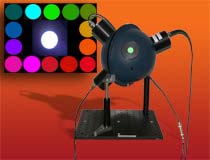Power and Electrical Engineering
This topic covers issues related to energy generation, conversion, transportation and consumption and how the industry is addressing the challenge of energy efficiency in general.
innovations-report provides in-depth and informative reports and articles on subjects ranging from wind energy, fuel cell technology, solar energy, geothermal energy, petroleum, gas, nuclear engineering, alternative energy and energy efficiency to fusion, hydrogen and superconductor technologies.

PNNL on fast track for hydrogen fuel reformer
Researchers at the Department of Energy’s Pacific Northwest National Laboratory are developing a system to rapidly produce hydrogen from gasoline in your car. “This brings fuel cell-powered cars one step closer to the mass market,” said Larry Pederson, project leader at PNNL. Researchers will present their developments at the American Institute for Chemical Engineers spring meeting in New Orleans, on April 27th, 2004.
Fuel cells use hydrogen to produce electricity which runs the vehicle

Portable ’rainbow’ source improves color calibrations
If you need bright blue light at a very specific wavelength, the National Institute of Standards and Technology (NIST) can make it—and fast.
In the world of color, this is no small accomplishment. NIST’s traditional light sources, such as incandescent lamps, are thermal. A blue thermal source would need to function at such a high temperature that components would melt. Lack of blue light sources introduces uncertainty when calibrating instruments that measure the color of things like

’Natural’ Sunlight In Offices 24 Hours A Day, Scientists Predict
New technology which can create ’natural’ sunlight in offices and homes and save billions on energy bills will soon be in everyday use, scientists will announce this week.
Researchers from the University of Bath will give details of work which will help change fundamentally the way that mobile phones, TVs, cars and buildings use lighting.
The new technology, called Solid State Lighting, will save billions of pounds by reducing the amount of electricity needed to li

ORNL researchers focus on the CO2 big picture
Spring’s lush green lawns and hot pink shoes contribute at least in a small way to the world’s total carbon picture, say researchers at the Department of Energy’s Oak Ridge National Laboratory.
Indeed, the latest fashions on Fifth Avenue and fertilizers that help homeowners achieve that “barefoot” lawn have their associated carbon dioxide costs, and ORNL’s Gregg Marland and Tristram West keep up with them. Their task is to track the total carbon produced worldwide and es

Researchers look at soy oil to replace petroleum for a range of products
Virginia Tech researchers are mixing air and soybean oil to create new polymers to replace petroleum-based materials.
“These natural polymers could be used in biocompatible or biodegradable ways,” says Tim Long of Blacksburg, chemistry professor in the College of Science at Virginia Tech. “We are looking for natural products derived in the United States.”
Ann R. Fornof of Toledo, Ohio, a graduate student in Virginia Tech’s Macromolecular and Science Engineering program, will

Research explains how to boost efficiency of polymer organic light-emitting diodes
Biasing spin statistics
Organic light-emitting diodes (OLEDs) based on pi-conjugated polymers offer significant advantages over other display materials. They are lightweight, flexible, easily tailored, operate on low voltages and can be deposited on large areas using simple techniques such as ink-jet printing or spin-coating.
By combining the electrical properties of metals and semiconductors with the mechanical properties of plastics, these materials are poised to provide a